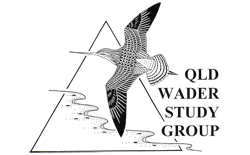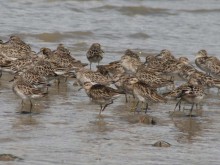Site information:
The artificial roost site, hides and interpretive centre at Kakadu Beach are the result of cooperation between the Queensland Wader Study Group and the developer of Pacific Harbour, a canal residential estate on Pumicestone Passage. The artificial roost site was built in 2002 to compensate for the loss of a natural roost site on the banks of Dux Creek, which was notable for accommodating up to 1000 Eastern Curlew on peak migration, as well as thousands of other waders. Built primarily of sand, the artificial roost site at Kakadu Beach has attracted a different balance of species than did the former site, which had a muddier substrate. However, in a relatively short time, a range of resident and migratory waders are already utilising the site and it is hoped that the list will expand to include most of the species using the extensive feeding grounds of Pumicestone Passage.
The Kakadu Beach roost site is 200 m long, with fencing and planted mangroves at either end to discourage entry by people and dogs. A long, tidally inundated lagoon was also constructed behind the roost site to buffer the birds from disturbance from people. Hides are positioned at either end of the site and are linked by a cement path.
Kakadu Beach is one of only a small number of roost sites in Pumicestone Passage that are above the highest astronomic tide level. When the high tide level is less than 2 m, a roost site at Toorbul, 4 km to the north-west, is preferred. However, when the Toorbul roost site is inundated, large numbers of waders flock to Kakadu Beach.
How to get there: From Brisbane, drive north along the Bruce Highway for about 44 km. Take the Bribie Island exit and follow this road for 19 km, through the township of Ningi, until reaching the bridge to the island. After crossing the bridge, turn left towards Banksia Beach at the second roundabout, continue for 3.8 km and turn left at the Solander Esplanade T-junction. There is a parking area at each of the hides. The parking area for the northern hide is at the entrance to the Kakadu Beach residential estate, beside the interpretive centre, 200 m from the T-junction. To get to the southern hide, drive into the estate and the next parking area on the right is near the hide.
Amenities/access: The nearest toilets are located 200 m to the north along The Esplanade and many picnic tables are located along the waterfront. This site is easily accessible for disabled people.
Site coordinates: Lat 27º 02’ 55” S, Long 153º 08’ 05” E.
Wader species: Whimbrel, Eastern Curlew, Bar-tailed Godwit, Great Knot, Red-necked Stint, Curlew Sandpiper, Pied Oystercatcher, Sooty Oystercatcher, Black-winged Stilt, Red-capped Plover, Double-banded Plover (March – August), Broad-billed Sandpiper, Lesser Sand Plover and Greater Sand Plover.
Other species: Gull-billed Tern, Little Tern, Caspian Tern, Lesser Crested Tern and Crested Tern.

